“5630 LED strips offer higher brightness, efficiency, and intensity, ideal for task-focused lighting. 5050 LED strips provide versatility, RGB color options, and balanced brightness for general decorative use. Clearly understanding these differences helps you select the perfect LED strip for your specific needs.”
Introduction to 5630 and 5050 LED Strips
Having personally worked extensively with both 5630 and 5050 LED strips, I’ve noticed clear distinctions between them that directly impact their ideal uses. Here’s a straightforward overview to help you clearly understand each type.
What is a 5630 LED Strip?
5630 LED strips utilize LEDs measuring 5.6mm × 3.0mm, renowned for their powerful brightness and energy efficiency. In my installations, these strips consistently deliver excellent illumination and uniform brightness, making them perfect for task-oriented or professional lighting projects where clarity and brightness are paramount.
What is a 5050 LED Strip?
5050 LED strips feature LEDs sized 5.0mm × 5.0mm, typically offering RGB color options and balanced brightness suitable for various decorative and ambient lighting applications. From my practical experience, their versatility makes them highly popular in residential and general commercial environments, particularly when colorful lighting effects or moderate brightness is desired.
People frequently ask me, “Are 5050 LEDs the brightest?” While 5050 LEDs offer excellent brightness and color versatility, 5630 LEDs typically provide significantly higher brightness and better efficiency, ideal for detailed or high-illumination needs.
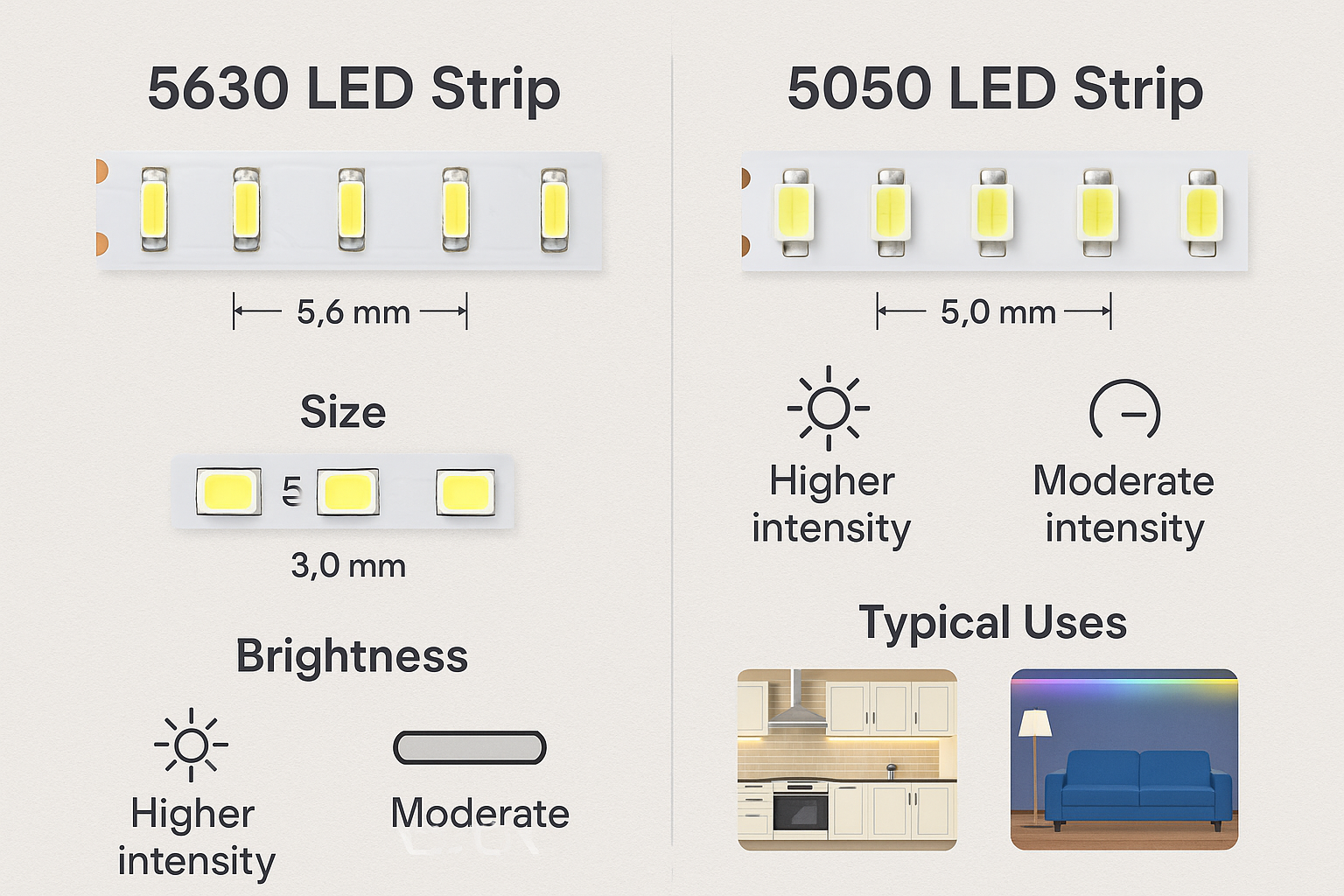
Technical Differences Clearly Explained
When choosing between 5630 and 5050 LED strips, clearly understanding their technical differences can greatly impact your lighting results. I’ve installed both types in various scenarios and can help clarify these technical aspects for you.
Brightness & Lighting Performance
- 5630 LED Strips:
Clearly known for their higher lumen output, typically around 45-50 lumens per LED, offering brighter, more intense illumination ideal for task-focused lighting.
- 5050 LED Strips:
Provide moderate brightness averaging about 15-20 lumens per LED. They deliver sufficient brightness for ambient and decorative purposes but are clearly outperformed by 5630 strips in terms of overall intensity.
Energy Efficiency & Power Usage
- 5630 LED Strips:
More energy-efficient relative to brightness output, offering high illumination per watt. However, higher brightness means slightly higher power consumption and heat output, requiring thoughtful power and thermal management.
- 5050 LED Strips:
Consume moderate power, suitable for general decorative use. Typically, they’re easier to handle in terms of power supply and heat management due to lower overall brightness and intensity.
Clients frequently ask me, “What’s better than 5050 LED?” Based on my hands-on experience, if your priority is brightness, efficiency, and high-intensity illumination, 5630 LED strips are clearly superior to 5050 LED strips.
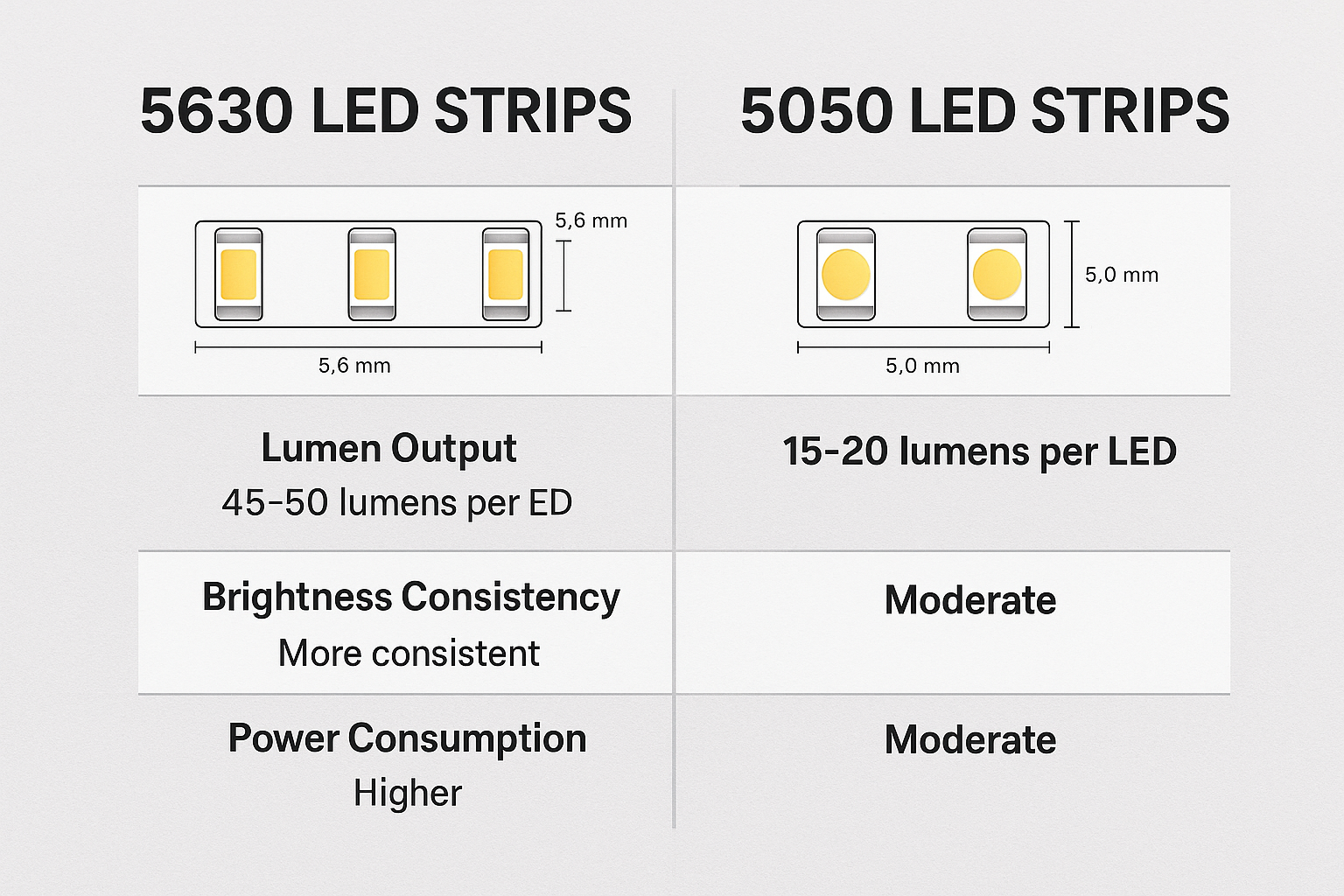
Advantages and Disadvantages of 5630 LED Strips
Having installed 5630 LED strips across numerous projects, I’d like to clearly outline their key benefits and some considerations to help you make an informed decision.
Advantages of 5630 LED Strips
- Higher Brightness:
Clearly provide superior illumination, making them ideal for task lighting, workspaces, kitchens, or commercial applications where bright, detailed lighting is essential.
- Improved Energy Efficiency:
Offer better lumen-per-watt performance, providing brighter illumination without significantly increasing power consumption.
- Enhanced Lighting Uniformity:
Deliver consistent brightness across the entire LED strip, ensuring uniform illumination clearly suitable for professional settings.
Disadvantages of 5630 LED Strips
- Increased Heat Output:
Higher brightness naturally produces more heat, requiring clear attention to proper heat dissipation strategies and potential additional installation complexity.
- Higher Initial Cost:
Typically more expensive compared to lower-density LED strips, which may affect budget considerations for certain projects.
People often inquire, “Are 5630 LEDs suitable for home use?” Clearly, while they can be used in homes, they’re especially effective for areas needing strong illumination like kitchens or home offices, rather than general decorative purposes.
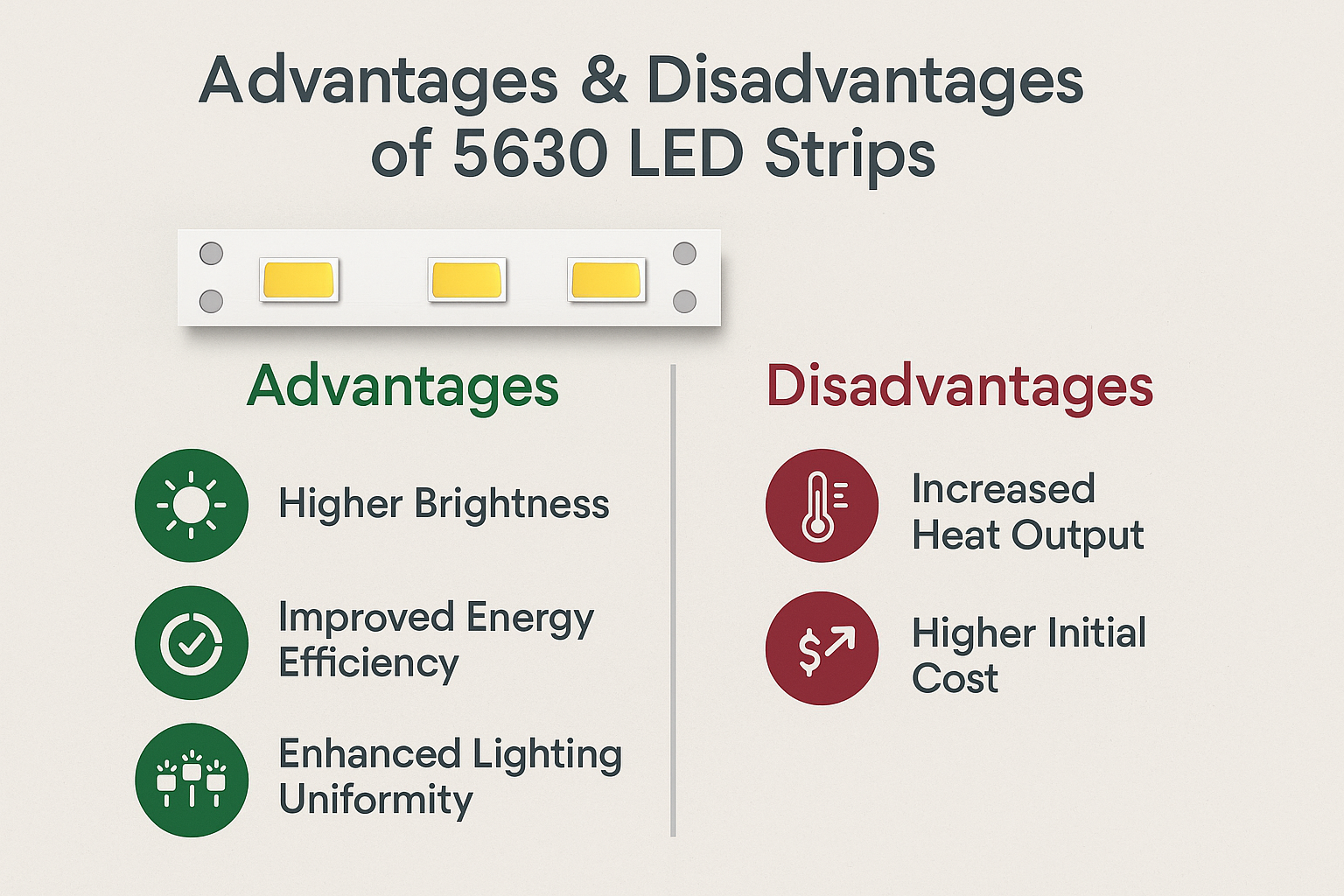
Advantages and Disadvantages of 5050 LED Strips
Based on my extensive experience installing and using 5050 LED strips, I’ll clearly outline their practical strengths and limitations, helping you make an informed decision for your lighting needs.
Advantages of 5050 LED Strips
- RGB Color Versatility:
Clearly offer multiple colors within a single LED, ideal for decorative lighting, ambiance creation, and flexible design scenarios.
- Balanced Brightness:
Provide sufficient illumination for general indoor and decorative purposes, making them excellent for residential or commercial accent lighting.
- Easy Installation and Handling:
Typically easier to install and manage, which makes them particularly suited for DIY and general-use installations.
- Cost-Effective:
Generally more affordable compared to higher-density or specialized LED strips, clearly benefiting budget-sensitive projects.
Disadvantages of 5050 LED Strips
- Lower Brightness Compared to 5630:
Not as suitable for detailed task lighting or areas requiring higher illumination intensity.
- Moderate Energy Efficiency:
Slightly less efficient in terms of lumen-per-watt output compared to 5630 strips, potentially impacting long-term energy costs.
Clients frequently ask me, “Are 5050 LEDs bright enough for general home lighting?” In my experience, yes—they are typically bright enough for ambient and decorative purposes, but clearly not ideal if you require strong, detailed task lighting.
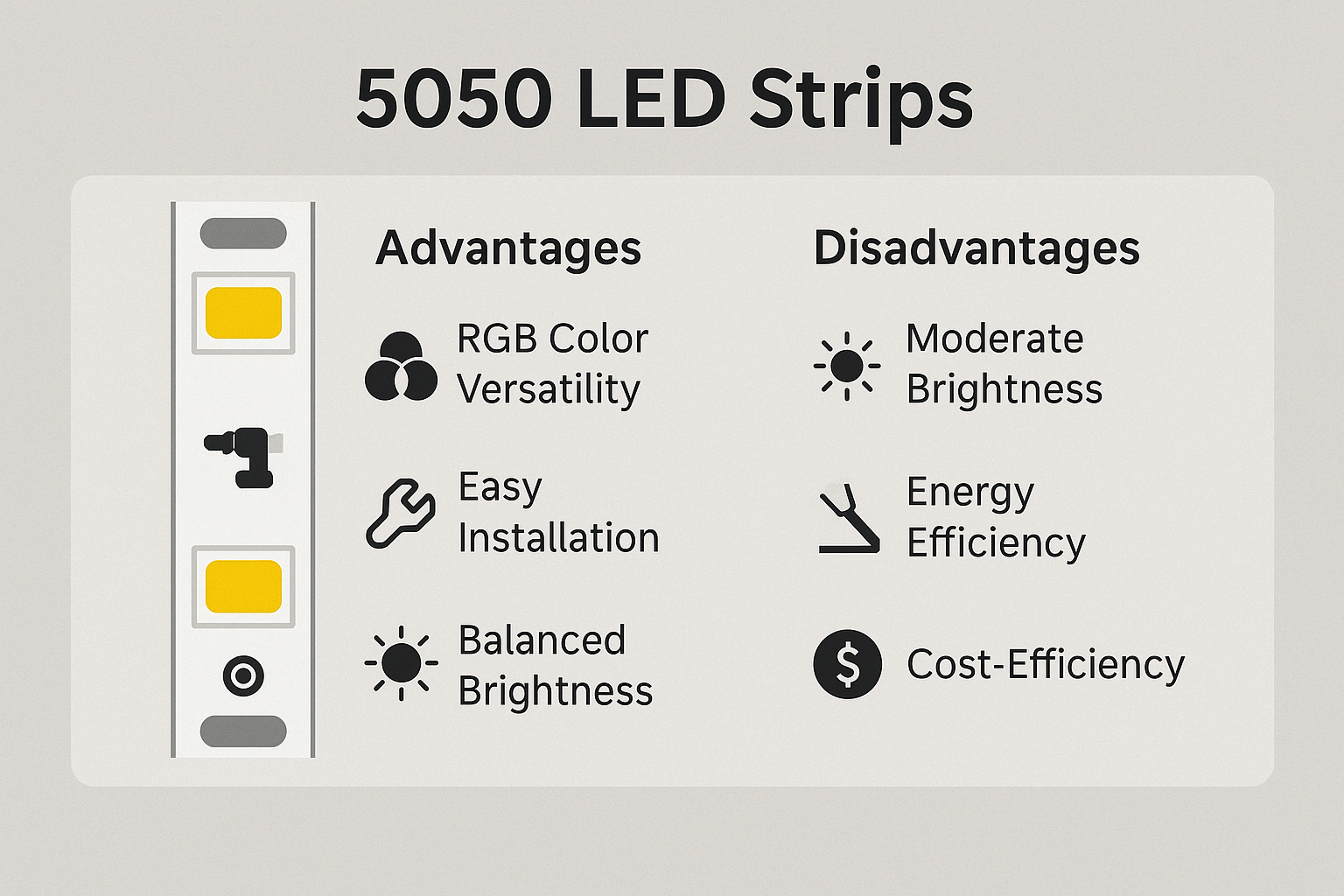
Best Applications & Practical Scenarios
Having personally installed both 5630 and 5050 LED strips in various scenarios, I clearly understand where each type excels. Here’s practical guidance based on my firsthand experience to help you choose wisely.
Ideal Uses for 5630 LED Strips
5630 LED strips clearly perform best in environments requiring high-intensity, detailed illumination, including:
- Task-Oriented Lighting:
Kitchens, workstations, offices, and garages, where clear visibility and brightness are essential.
- Retail & Commercial Spaces:
Clearly ideal for retail shelves, product displays, and commercial interiors where strong lighting helps showcase products effectively.
- Professional Applications:
Architectural lighting, museums, galleries, and display cases needing precise, consistent brightness and clarity.
Ideal Uses for 5050 LED Strips
5050 LED strips are clearly best suited for versatile, decorative, and flexible installations such as:
- Ambient Residential Lighting:
Perfect for living rooms, bedrooms, and decorative accent lighting that doesn’t require intense illumination.
- Decorative and RGB Lighting:
Excellent for creating dynamic, colorful lighting effects in bars, restaurants, and entertainment spaces.
- General Commercial Interiors:
Clearly suited for general commercial use, providing balanced brightness and ease of installation.
People often ask, “Should I use 5050 or 5630 LEDs in my home?” From my practical experience, 5050 LEDs are generally better for decorative or ambient home lighting, whereas 5630 LEDs clearly shine in task-oriented or professional lighting scenarios.
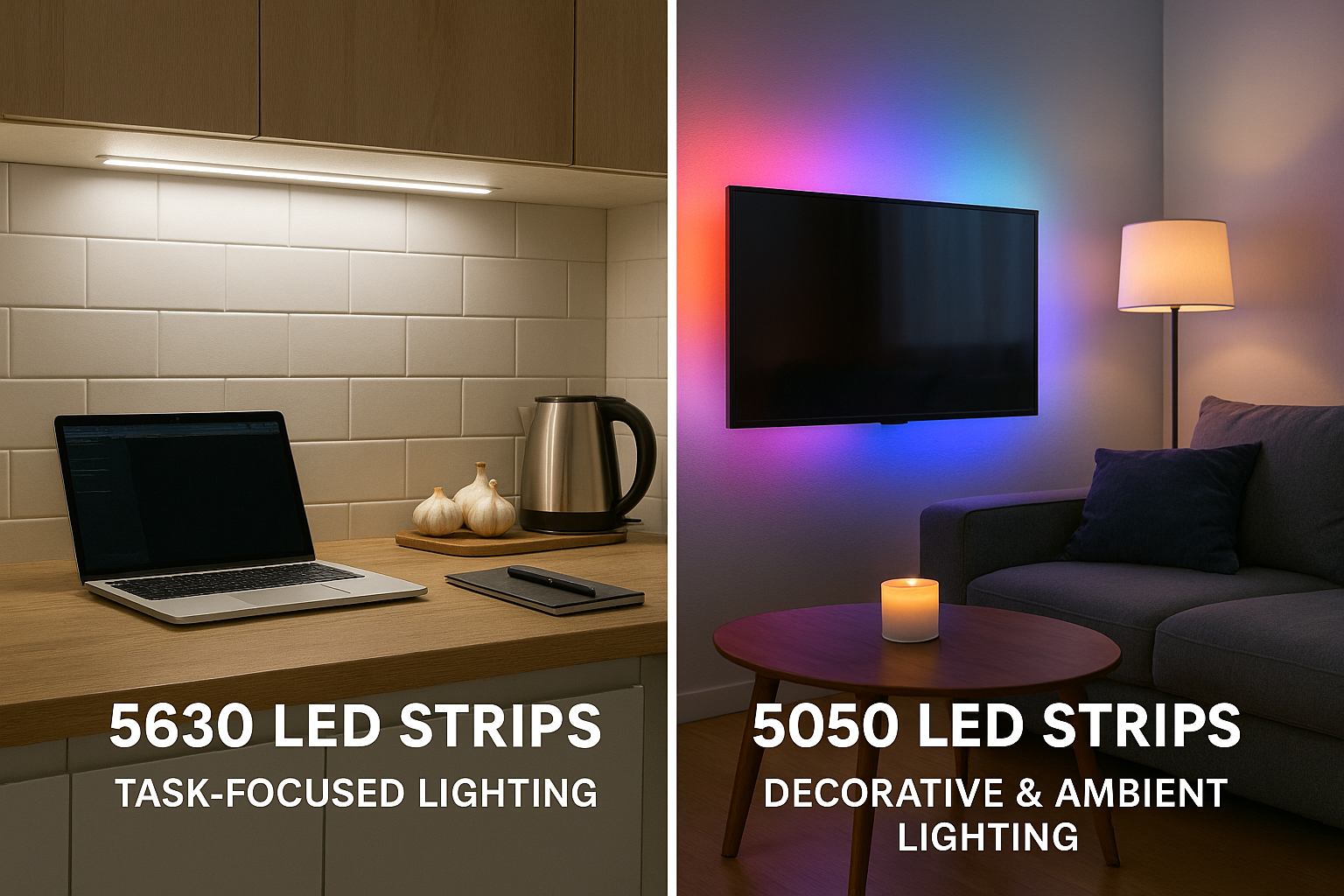
How to Choose Between 5630 and 5050 LED Strips
Drawing on my extensive experience installing LED strips, I understand clearly the importance of selecting the right LED strip type based on your specific lighting needs. Here’s straightforward advice on the key factors to consider when deciding between 5630 and 5050 LED strips.
Key Factors to Consider
- Brightness Requirements:
If your project demands high-intensity and consistent brightness, 5630 LED strips clearly offer superior illumination. For moderate brightness and decorative effects, 5050 LED strips are clearly sufficient.
- Application Environment:
Consider the installation location. 5630 LEDs are clearly ideal for task-oriented spaces like offices, kitchens, and retail environments, whereas 5050 LEDs are better suited to decorative, ambient areas.
- Installation Complexity:
5050 LED strips generally offer simpler installation, flexibility, and easier handling, clearly advantageous for DIY or casual lighting projects.
- Budget Considerations:
Clearly define your budget upfront—5050 LED strips typically offer better affordability, whereas 5630 LED strips are often more expensive due to higher brightness and efficiency.
Common Mistakes and Practical Recommendations
- Mismatching Brightness Needs:
A common mistake I’ve seen is choosing 5050 LEDs for areas clearly needing task-focused brightness, or opting for 5630 LEDs unnecessarily for purely decorative purposes.
- Underestimating Power Requirements:
5630 LEDs clearly require robust power supplies and adequate heat management—plan accordingly to avoid installation complications.
- Overlooking Application Purpose:
Clearly evaluate your project’s purpose upfront—whether decorative, ambient, or task-focused—to ensure the right LED strip density and type is selected.
People frequently ask me, “Is 5630 LED always better than 5050 LED?” Clearly, this depends on your project’s specific needs—5630 LEDs offer higher brightness and efficiency, ideal for detailed or professional lighting. In contrast, 5050 LEDs provide versatility, affordability, and easy handling, perfect for general or decorative lighting.
External Link:
LED 5050 Vs 5630 – Moonleds
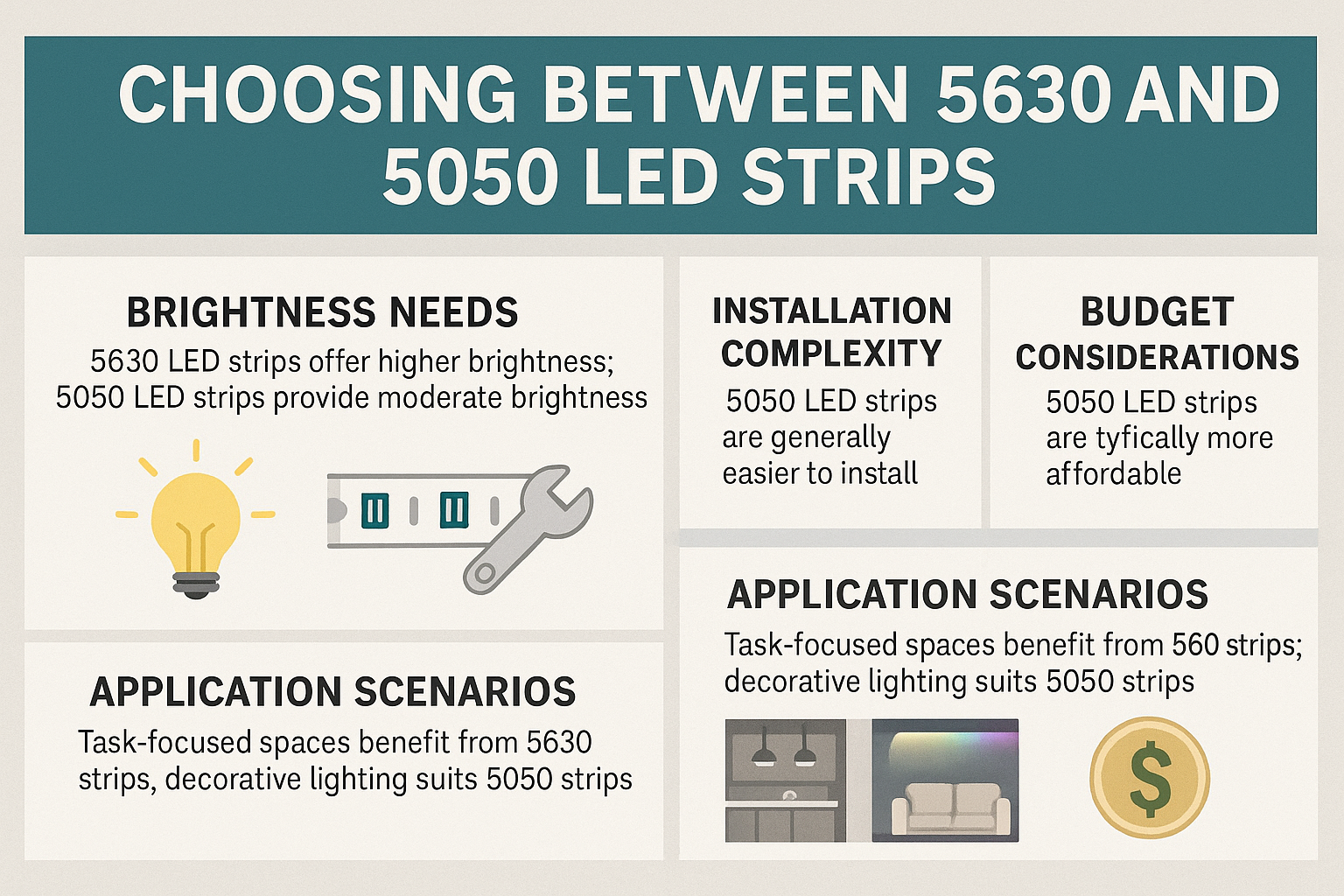
Installation, Maintenance & Expert Recommendations
From my hands-on experience installing both 5630 and 5050 LED strips, I clearly understand the importance of proper installation and maintenance. Here’s practical guidance, clear step-by-step instructions, and troubleshooting advice to help ensure your LED strips perform reliably.
Step-by-Step Installation Guide
5630 LED Strip Installation:
- Preparation and Measurement:
Clearly measure your installation area, ensuring you account for power supply and heat dissipation needs.
- Mounting Method:
Use mounting clips or aluminum channels clearly designed for enhanced heat management due to higher brightness and heat output.
- Secure Connections:
Clearly and firmly connect to an appropriate power supply that meets the higher power demands of 5630 LEDs.
- Test and Adjust:
Turn on power carefully and test all segments for consistent brightness and secure connections.
5050 LED Strip Installation:
- Surface Preparation:
Ensure the installation surface is clean and smooth for optimal adhesive performance.
- Easy Installation:
Use the adhesive backing to easily and firmly attach LED strips, clearly avoiding tight bends or twists.
- Power Connection:
Connect clearly to a suitable constant voltage power source, verifying polarity and power compatibility.
- Final Checks:
Clearly test for uniform brightness and consistent color output before completing installation.
Essential Maintenance Practices
- Regular Inspections:
Periodically inspect LED strips for loose connections, decreased brightness, or signs of overheating, clearly addressing any issues promptly.
- Effective Heat Management:
Clearly prioritize proper heat dissipation, especially for 5630 strips, by using aluminum channels or other cooling solutions.
- Cleaning and Care:
Occasionally clean LED strips gently with a soft cloth to remove dust or debris clearly, maintaining brightness and performance.
Troubleshooting Common Issues
- Brightness Inconsistency:
Clearly check for adequate power supply and secure connections. Confirm voltage compatibility to avoid inconsistent brightness issues.
- Overheating (Especially 5630 LEDs):
Improve heat dissipation clearly by adding cooling solutions or using suitable aluminum channels to maintain optimal operating temperatures.
- LED Strips Not Lighting Up:
Verify polarity, proper power supply, and clearly inspect for any loose or incorrect connections.
Many users ask me, “What common issues arise during LED strip installations?” In my experience, the most frequent challenges include inadequate power supplies, improper heat dissipation, incorrect connections, and adhesive failures.
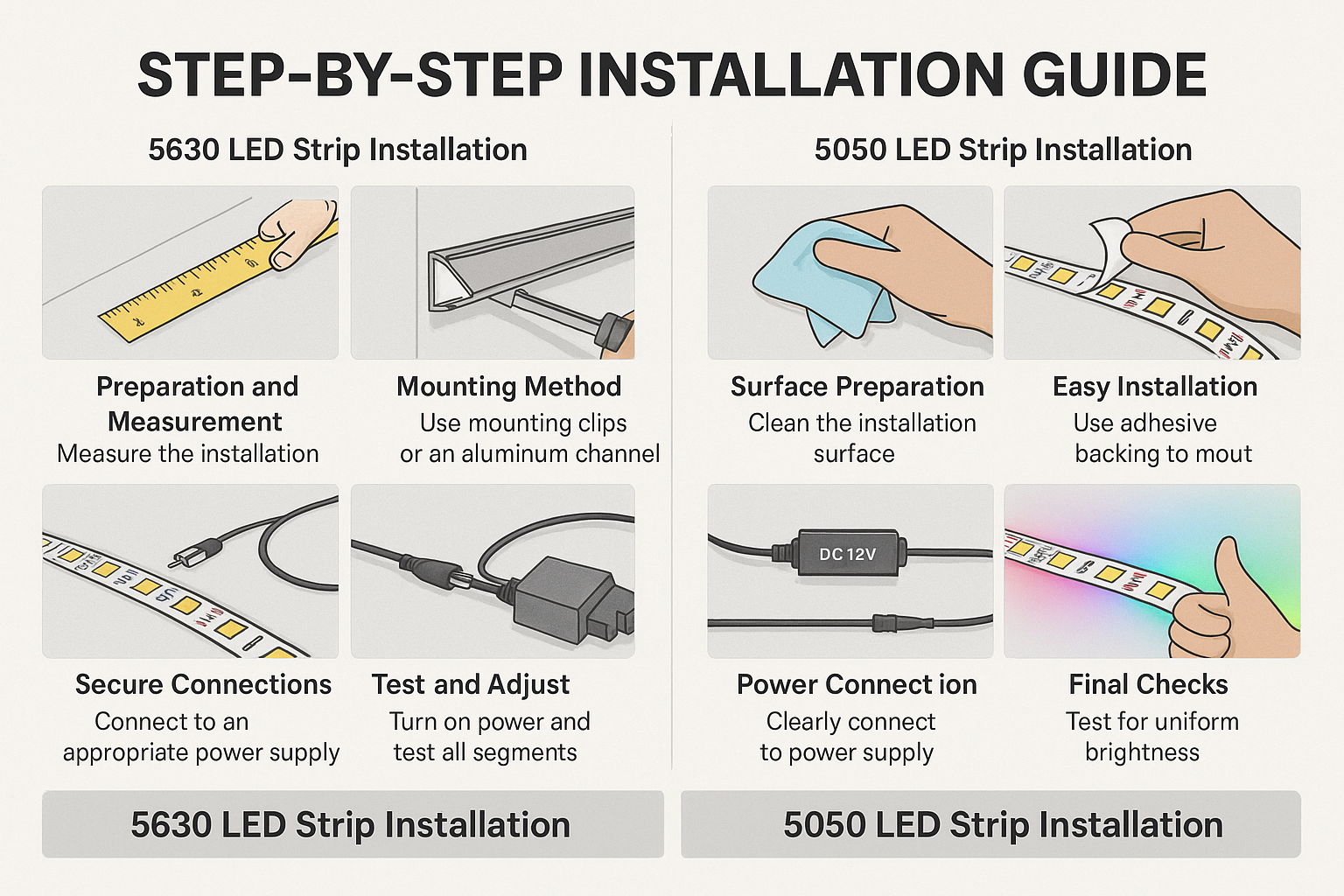
FAQs About 5630 and 5050 LED Strips
Drawing from my experience, I clearly address below some of the most common questions I regularly encounter about 5630 and 5050 LED strips. These insights should help clarify your understanding and guide your selection process.
Are 5630 LEDs brighter than 5050 LEDs?
Yes, 5630 LEDs typically provide significantly brighter illumination than 5050 LEDs. This makes them clearly preferable for detailed, task-oriented lighting installations requiring higher brightness.
Which LED type is more energy-efficient?
In my experience, 5630 LEDs are generally more energy-efficient, delivering higher lumen output per watt compared to 5050 LEDs. However, because they are brighter, overall power usage might be higher, requiring proper power management.
Can I use 5050 LED strips for detailed task lighting?
Generally, 5050 LED strips are better suited for decorative, ambient, or general lighting. For detailed, task-focused lighting applications requiring brighter and more consistent illumination, 5630 LED strips are clearly the better choice.
Conclusion & Next Steps
Clearly understanding the differences between 5630 and 5050 LED strips will greatly help you achieve optimal results in your lighting projects. From my practical experience, if you’re aiming for high-intensity, detailed task lighting, the 5630 LED strip is clearly your best choice. On the other hand, for general ambient and decorative lighting scenarios where flexibility and affordability are essential, the 5050
LED strip clearly provides excellent value and ease of use.
I hope my insights have clearly guided you toward making an informed, confident choice tailored specifically to your project.
Ready to select the perfect LED strip lighting for your needs?
Explore Elstar’s LED Lighting Solutions →








